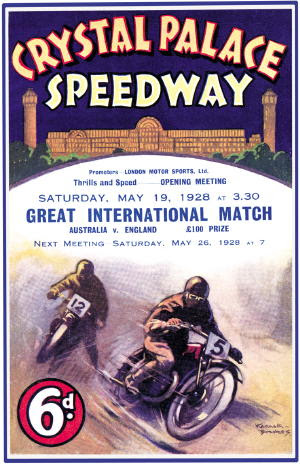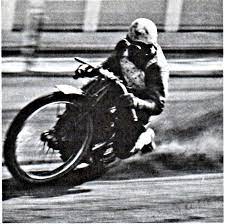Wilfred Steward Lamont also known as Billy Lamont was but 15-years-old when Johnnie Hoskins ‘invented’ speedway at West Maitland in December 1923. Speedway was much later defined as ‘racing motorcycles on oval dirt tracks by professional riders in organised leagues on single gear machines with no brakes’.
That may well be, but whatever he was riding, brakes or not, young Wilfred proved to be devastatingly adept around the growing number of ragtag events held at showgrounds and horse trotting tracks along the east coast of Australia.

Now known as Billy, he’d yet to turn 21 when he was signed up to the team Johnnie Hoskins had pulled together to sail to England in March 1928. Independent as ever, Billy elected to travel solo via Los Angeles and San Francisco rather than join the team on the Orient liner Oronsay out of Sydney. All arrived in England in what was said to be the best summer for some years.
On the pace and on the money from the off, Billy was soon racing six times a week. In May the Sydney Sun newspaper reported that Billy was “cornering at tremendous speed and was thrown against the fence before remounting and winning the race”. Not possible, surely? Billy was actually riding a donkey in a novelty race at White City!
Due to his daredevil style, the popular Aussie had become known as Cyclone Billy or simply Cyclone. The Brisbane Courier newspaper published that Cyclone Billy, “wearing a cream jersey with two Aussie flags thereon”, took on the American ace Art Pechar in an Australia versus America match race.

Cyclone, riding a 3hp AJS, not only blitzed the American on his Harley-Davidson Peashooter, but also broke London’s Stanford Bridge track record by three seconds. After which he was “mobbed and carried around the track, causing the crowd to gasp, scream and go mad”. And no doubt get Billy’s stylish cream jersey absolutely filthy!
By 1931 speedway had crossed the Channel to Europe. In May that year, in what was billed by the irrepressible Hoskins as a world championship, a meeting was held at Buffalo Stadium in Paris. Cyclone Billy was crowned the 1931 world champion.
The promotion proved such a success with Parisians that a second world championship was held at the same venue in October; won by Australian Vic Huxley. Only six months later, Aussie ‘Bluey’ Wilkinson – the English world champion – was crowned the French world champion. Hoskins was on a roll, having already crowned a world champion in Australia over the summer break.
When Billy suffered a fractured skull at Coventry in 1932, such was his fame that his recovery was reported on daily. Certainly he became more of a celebrity in England than on his home tracks Down Under. However nothing could match his fame when he won a second solo world championship in Paris in 1935; the last ever held at Buffalo Stadium.
WORDS: PETER WHITAKER PHOTOGRAPHY: AMCN ARCHIVES











